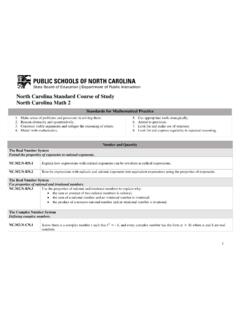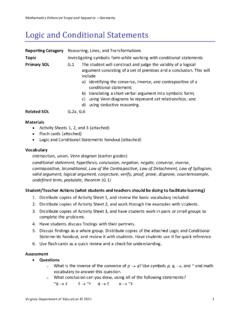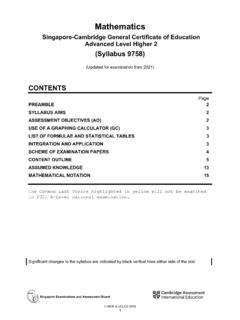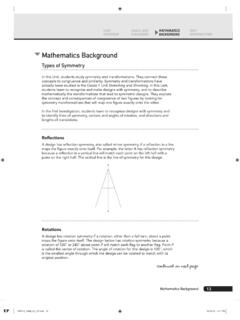Transcription of Transformations of Linear Functions - MR. JONES
1 Copyright McGraw-Hill EducationLesson 4-4 Transformations of Linear FunctionsStudy TipSlope When translating a Linear function, the graph of the function moves from one location to another, but the slope remains the same. Today s Vocabularyfamily of graphsparent functionidentity functiontransformationtranslationdilatio nreflectionWatch Out!Translations of f (x) When a translation is the only transformation performed on the identity function, adding a constant before or after evaluating the function has the same effect on the graph. However, when more than one type of transformation is applied, this will not be the Transforming Linear Functions Online Activity Use graphing technology to complete an Explore. INQUIRY How does performing an operation on a Linear function change its graph?
2 Learn Translations of Linear FunctionsA family of graphs includes graphs and equations of graphs that have at least one characteristic in common. The parent function is the simplest of the Functions in a family of Linear Functions includes all lines, with the parent function f (x) = x also called the identity function. A transformation moves the graph on the coordinate plane, which can create new Linear type of transformation is a translation. A translation is a transformation in which a figure is slid from one position to another without being turned. A Linear function can be slid up, down, left, right, or in two directions. Vertical TranslationsWhen a constant k is added to a Linear function f (x), the result is a vertical translation. The y-intercept of f (x) is translated up or Concept Vertical Translations of Linear FunctionsThe graph g(x) = x + k is the graph of f (x) = x translated k > 0, the graph of f (x) is translated k units > 0k = 0 Every point on the graph of f(x) moves k units k < 0, the graph of f (x) is translated |k| units = 0k < 0 Every point on the graph of f(x) moves |k| units s Goals Apply translations to Linear Functions .
3 Apply dilations to Linear Functions . Apply reflections to Linear 4-4 Transformations of Linear Functions 239 THIS MATERIAL IS PROVIDED FOR INDIVIDUAL EDUCATIONAL PURPOSES ONLY AND MAY NOT BE DOWNLOADED, REPRODUCED, OR FURTHER McGraw-Hill Education Example 1 Vertical Translations of Linear FunctionsDescribe the translation in g(x) = x - 2 as it relates to the graph of the parent the parent graph for Linear f(x) = x, g(x) = f(x) + k where . g(x) = x - 2 The constant k is not grouped with x, so k affects the , or . The value of k is less than 0, so the graph of f(x) = x is translated units down, or 2 units (x) = x - 2 is the translation of the graph of the parent function 2 units Describe the translation in g(x) = x - 1 as it relates to the graph of the parent graph of g(x) = x - 1 is a translation of the graph of the parent function 1 unit.
4 Horizontal TranslationsWhen a constant h is subtracted from the x-value before the function f (x) is performed, the result is a horizontal translation. The x-intercept of f (x) is translated right or Concept Horizontal Translations of Linear FunctionsThe graph g(x) = (x h) is the graph of f (x) = x translated h > 0, the graph of f (x) is translated h units = 0h > 0 Every point on the graph of f (x) moves h units h < 0, the graph of f (x) is translated |h| units < 0h = 0 Every point on the graph of f (x) moves |h| units left. Go Online You can complete an Extra Example online. Think About It!What do you notice about the y-intercepts of vertically translated Functions compared to the y-intercept of the parent function? xf(x)f(x) - 2(x, g(x))-2-2-4(-2, -4) 0 0-2(0, -2) 1 1-1(1, -1)yxOg(x)f(x) Go OnlineYou can watch a video to see how to describe translations of Notes Go OnlineYou may want to complete the Concept Check to check your Module 4 Linear and Nonlinear FunctionsSample answer: The y-intercepts move up k units or down |k| units from the y-intercept of the parent = -2f (x) + (-2)outputy-values |-2| downTHIS MATERIAL IS PROVIDED FOR INDIVIDUAL EDUCATIONAL PURPOSES ONLY AND MAY NOT BE DOWNLOADED, REPRODUCED, OR FURTHER McGraw-Hill EducationExample 2 Horizontal Translations of Linear FunctionsDescribe the translation in g(x) = (x + 5) as it relates to the graph of the parent the parent graph for Linear f(x) = x, where h = -5.
5 G(x) = (x + 5) The constant h is grouped with x, so k affects the , or . The value of h is less than 0, so the graph of f(x) = x is translated units left, or 5 units left. g(x) = (x + 5) is the translation of the graph of the parent function 5 units Describe the translation in g(x) = (x + 12) as it relates to the graph of the parent graph of g(x) = (x + 12) is a translation of the graph of the parent function 12 units . Example 3 Multiple Translations of Linear FunctionsDescribe the translation in g(x) = (x - 6) + 3 as it relates to the graph of the parent the parent graph for Linear Functions . Since f(x) = x, where and . g(x) = (x - 6) + 3 The value of h is grouped with x and is greater than 0, so the graph of f(x) = x is translated . The value of k is not grouped with x and is greater than 0, so the graph of f(x) = x is translated.
6 G(x) = (x - 6) + 3 is the translation of the graph of the parent function 6 units right and 3 units up. Think About It!What do you notice about the x-intercepts of horizontally translated Functions compared to the x-intercept of the parent function? Go Online You can complete an Extra Example + 5f(x + 5)(x, g(x))-233(-2, 3) 055(0, 5) 166(1, 6)yxOf(x)g(x)xx - 6f(x - 6)f(x - 6) + 3 (x, g(x))-2-8-8-5(-2, -5) 0-6-6-3(0, -3) 1-5-5-2(1, -2)yxOg(x)f(x) Think About It!Eleni described the graph of g(x) = (x 6) + 3 as the graph of the parent function translated down 3 units. Is she correct? Explain your reasoning. Lesson 4-4 Transformations of Linear Functions 241 Sample answer: The x-intercepts move right h units or left |h| units from the x-intercept of the parent |-5| g(x) = f(x - h)g(x) = f(x - (-5))leftg(x) = f(x - h) + kg(x) = f(x - 6) + 3 h = 6k = 36 units right3 units upSample answer: Yes; g(x) = (x 6) + 3 can be simplified to g(x) = x 3, which is the same as g(x) = f(x) MATERIAL IS PROVIDED FOR INDIVIDUAL EDUCATIONAL PURPOSES ONLY AND MAY NOT BE DOWNLOADED, REPRODUCED, OR FURTHER McGraw-Hill Education Go Online You can complete an Extra Example online.
7 Example 4 Translations of Linear FunctionsTICKETS A Web site sells tickets to concerts and sporting events. The total price of the tickets to a certain game can be modeled by f(t) = 12t, where t represents the number of tickets purchased. The Web site then charges a standard service fee of $4 per order. The total price of an order can be modeled by g(t) = 12t + 4. Describe the translation of g(t) as it relates to f(t).Complete the steps to describe the translation of g(t) as it relates to f(t). Since f(t) = 12t, g(t) = f(t) + k, where k = 4. g(t) = 12t + 4 f(t) + The constant k is added to f(t) after the total price of the tickets has been evaluated and is greater than 0, so the graph of will be shifted 4 units up. g(t) = 12t + 4 is the translation of the graph of f(t) units.
8 Graph the parent function and the translated function. yxO121 134 1 2f(t)g(t)Check RETAIL Jerome is buying paint for a mural. The total cost of the paint can be modeled by the function f(p) = He has a coupon for $ off his purchase at the art supply store, so the final cost of his purchase can be modeled by g(p) = - Describe the translation in g(p) as it relates to f(p).242 Module 4 Linear and Nonlinear Functions4 The graph of g(p) = - is the translation of the graph of f (p) units MATERIAL IS PROVIDED FOR INDIVIDUAL EDUCATIONAL PURPOSES ONLY AND MAY NOT BE DOWNLOADED, REPRODUCED, OR FURTHER McGraw-Hill Education Go Online You can complete an Extra Example Dilations of Linear FunctionsA dilation stretches or compresses the graph of a a Linear function f (x) is multiplied by a positive constant a, the result a f (x) is a vertical dilation.
9 Key Concept Vertical Dilations of Linear FunctionsThe graph of g(x) = ax is the graph of f (x) = x stretched or compressed |a| > 1, the graph of f (x) is stretched vertically away from the |a| > 1a = 1(x, y)(x, ay)The slope of the graph of a f (x) is steeper than that of the graph of f (x).If 0 < |a| < 1, the graph of f (x) is compressed vertically toward the < |a| < 1a = 1(x, y)(x, ay)The slope of the graph of a f (x) is less steep than that of the graph of f (x).When x is multiplied by a positive constant a before a Linear function f (a x) is evaluated, the result is a horizontal dilation. Key Concept Horizontal Dilations of Linear FunctionsThe graph of g(x) = (a x) is the graph of f(x) = x stretched or compressed |a| > 1, the graph of f (x) is compressed horizontally toward the |a| > 1a = 1(x, y) x, y1a()The slope of the graph of f(a x) is steeper than that of the graph of f(x).
10 If 0 < |a| < 1, the graph of f (x) is stretched horizontally away from the < |a| < 1a = 1(x, y) x, y1a()The slope of the graph of f(a x) is less steep than that of the graph of f(x).Watch Out!Dilations of f(x) = x When a dilation is the only transformation performed on the identity function, multiplying by a constant before or after evaluating the function has the same effect on the graph. However, when more than one type of transformation is applied, this will not be the case. Go OnlineYou can watch a video to see how to describe dilations of 4-4 Transformations of Linear Functions 243 THIS MATERIAL IS PROVIDED FOR INDIVIDUAL EDUCATIONAL PURPOSES ONLY AND MAY NOT BE DOWNLOADED, REPRODUCED, OR FURTHER McGraw-Hill Education Think About It!What do you notice about the slope of the horizontal dilation g(x) compared to the slope of f(x)?






